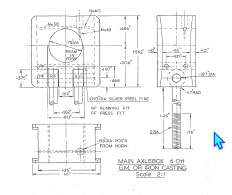Torquay Manor 5 Gauge Axle boxes
Torquay Manor 5 Gauge Axle boxes
- This topic has 13 replies, 8 voices, and was last updated 23 August 2024 at 14:35 by
duncan webster 1.
Viewing 14 posts - 1 through 14 (of 14 total)
Viewing 14 posts - 1 through 14 (of 14 total)
- Please log in to reply to this topic. Registering is free and easy using the links on the menu at the top of this page.
Latest Replies
Viewing 25 topics - 1 through 25 (of 25 total)
-
- Topic
- Voices
- Last Post
Viewing 25 topics - 1 through 25 (of 25 total)
Latest Issue
Newsletter Sign-up
Latest Replies
- Use horizontal mill as saw for metal?
- Steam pressure using thermistor
- Potential new society in North Yorkshire
- N Devon Model Engineers, is this the end?
- Motor bearings and more
- Hello
- Re-Visiting My Stuart Victoria
- Good quality Jewellers screwdrivers.
- Small type Reilang oil gun
- Half Scale 1/4HP A J Weed Engine





